El Coyote (character)
| El Coyote | |
|---|---|
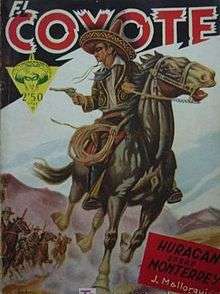 Cover illustrated by Francisco Batet Spanish Ediciones Cliper, Barcelona El Coyote pulp novel #2, October 1944 | |
| First appearance |
Novelas del Oeste, novel N° 9, late 1943, El Coyote (Editorial Molino, Barcelona)[1] |
| Created by | José Mallorquí[2] |
| Information | |
| Aliases | César de Echagüe (El Coyote) |
| Nationality |
A pulp novel series from Spain 1944-1953, with 192 stories from California 1846-1876, published by Ediciones Cliper |
El Coyote (the Coyote)[3] is the name of a fictional character very similar to Zorro (El Zorro), the Fox, although acting several years later (when California had transformed to be a part of USA's "Wild West"). He first appeared in a Spanish Novelas del Oeste ("Stories of the West") Number 9 pulp novel, written by Carter Mulford,[4] one of several pseudonyms of the successful Spanish author José Mallorquí Figuerola from Barcelona (1913–1972).[5] The novel was issued by the Spanish publishing house Editorial Molino. Mallorquí now started writing a series of extremely popular novels, with the character "El Coyote" in the head role, for Ediciones Cliper. Between September 1944 and late 1953 the hero appeared in a series of 192 pulp-like EL COYOTE novels,[6] with several revivals throughout the years.[7] They covered 30 years of chronological adventures from 1851 (and earlier) until around 1876, or possibly later (the original Cliper novels were not published in strict chronological order). Cover illustrators were not always identical to inside illustrators. The novels (a Cliper edition already in 1947)[8] - and the comics - were also glued in nice collections and sold in hardbound "limited bookform" (Forum had one with all its novels,[9] and also one with the comics).
The Spanish editions
- Cliper (1944-1953)[10] - the original editions (which also featured the very first novel, El Coyote)[11] - 192 novels (3 pesetas each - later 4 and 5), covers and insides illustrated by Francisco Batet (Pellejero).[12] The first 120 "El Coyote" started with La vuelta del Coyote ("The return of El Coyote"),[13] in September 1944.[14] There also were 10 Numero Extra (see below - including one Extra Especial) - and finally 62 "Nuevo Coyote" were published.[15]
- Cid (1961-1964)[16] with reeditions of above in one series (18,4x10,8 cm) illustrated by Jano (Francisco Fernandez Zarza-Pérez) and possibly others.[17]
- Bruguera (1968-1971)[18] with 110 of the early novels (including nine Extras, but not the Especial) - with El proscrito de las lomas as the last (17,5x10,5 cm) illustrated by Antonio Bernal (Romero).
- Favencia (1973-1977)[19] with the 192 novels (18x11 cm) illustrated by Jano, Carlos Prunés, Pedro Alferes Gonzales and others.
- Forum (1983-1984)[20] with 96 reedited double volumes (19x14 cm)[21] - covers illustrated by Salvador Fabá; insides by Julio Bosch and José Maria Bellalta.[22]
- Planeta DeAgostini (2003-2004)[23] with the above 96 (21x15 cm) illustrated by Tony Fejzula & R.M. Gera.[24]
The Hero and the Novels
California was incorporated into the USA in 1848 as a result of the Mexican-American War 1846-1848 (after some turbulent years as part of Mexico and even twice as a short-lived independent republic), and registered as the 31st State of the United States in 1850.[25]
El Coyote's identity
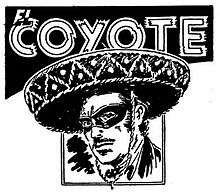
illustrated by Francisco Batet, 1947
César de Echagüe (the III - with Mexican and Spanish roots) was a wealthly, elegant Californian nobleman, resident at the large 40.000 hectare ranch, San Antonio,[26] just north-east of Los Angeles.[27] He had an affable, charming appearance - lazy, comfortable, cynical and sceptic, and with false superficiality.[28] He was educated and refined, a master of expression, and a practical, pragmatic man. Behind his facade he doubled as El Coyote, a masked vigilante hero and defender of the weak - fighting for freedom, honesty and justice.[29] Coyote protected the original Hispanics (and the native Indians) of California from the Anglo Americans, and certainly from all "bad ones". Mallorquí did address the Afro American question only briefly.[30] The stories continued the mythical traditions of Robin Hood, Dick Turpin, and The Scarlet Pimpernel - published in 1905, which was the very first popular novel with the "double identity" plot. Zorro found its way to the public in 1919, but El Coyote became even bigger - in Spain. Other early famous masked heroes were The Shadow, debuting 1930 and 1931, and the Spider 1933. Also debuting in 1933, Superman, and in 1936 The Phantom, plus Batman in 1939 and Captain America in 1941, were comic strip heroes - no novels.
Coyote's appearance
Coyote wore a black (mostly illustrated as dark blue, also in the comics - and sometimes brown) Mexican, decorated charro costume.[31] He had high black boots (mostly outside the trousers) and a decorated sombrero, a black shirt - neither blue nor red - although most drawings show a white shirt (on the Scandinan covers blue), with a black (sometimes shown as red or blue) silk scarf or a red tie. He also had a broad black silk belt (sometimes illustrated as a red silk one - although mostly as an American brown belt), plus two holstered revolvers hanging low on ammunition belts. Some illustrations show only one revolver with holster - others two revolvers on one ammunition belt. He also had a knife - and a rifle, a lasso and a Mexican sarape on his horse - and he wore gloves. The mask covered more of his upper face than shown on most of the fine drawings by Francisco Batet (and especially by several others). The Scandinavian covers presented a relatively large mask (illustrated by Harald Damsleth). In at least one of the early pulps Mallorquí wrote he wore "Mexican peasant clothes" (black - shown brown on some early illustrations).[32] Coyote had two "marks" - one was shooting at an ear lobe of his villains, one was a drawing of a wolf's head on messages.[33]
The original Spanish novels
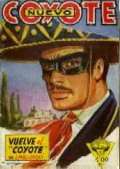
The very first Cliper
Nuevo Coyote
novel #1, mid 1951
The novel series mostly comprised the years from December 1851 (and with Cliper number 6 from early 1865) to around 1875. Published in Spain, they originally consisted of 120 volumes 1944-1951 - the last titled Alias el Coyote in March 1951. The novels were not always strictly chronological.[34] One of the last in the first series, El hogar de los valientes, was an 1854 adventure. Another example was the 1850/1852 (extended, 6 pesetas) story El diablo, Murrieta y el Coyote,[35] Cliper novel number 100. There was also the very late La gloria de don Goyo (which told a story of April 1865 - late civil war era soon after César's "second arrival" in Los Angeles, where the Bella Union and Fort Moore were two frequently featured establishments in the novels). A late original Cliper novel, the six-year-celebration novel La casa de los Valdez and its sequel, told a story César picked up in Spain in 1857 about César I (his grandfather arriving in California in 1767 - the story begins and ends in 1872 at home at the San Antonio ranch). Simultaneously published were 10 Numero Extra (1945-1946), including a reedited version of the original 1943 pulp El Coyote (issued as Edicion Cliper Extra #0 in 1945) and the Especial of 1946 noted below (no numbering at all). The Extras told stories of pre-1851, early (and also late) 1850s and mid/late 1860s. Later came 62 "reformed" Nuevo Coyote (still on Cliper 1951-1953)[36] - the first published in mid 1951 (Vuelve el Coyote) and telling later, new stories - some intervening in the old chronology (some relating to 1872) - and with a pocket size, turning from 19,7x14,7 cm and 64 pages to 15,5x10,7 cm and 128 pages.[37] The last Nuevo Coyote was titled Los asesinos llegan a Monterrey,[38] aka El Coyote Los asesinos van a Monterrey.[39]
International publishing
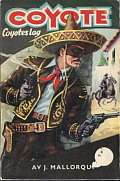
The early "Coyote" novels were published in 16 countries in nine different languages.[40] Italy published all 192, often with the same covers as Cliper and with the later ones (with non-Cliper covers) illustrated by Emilio Uberti (and especially Sergio Tarquinio inside).[41] Germany published 84 novels,[42] mostly with Batet's original Cliper illustrations - plus reeditions (different publishers) with new illustrators. Finland had 78 volumes, mostly with Batet illustrations.[43] The original editions in Norway, Denmark and Sweden (with no illustration inside) often had identical covers (special unique ones made for these three countries 18x12 cm). The illustrations on the Scandinavian editions, by Harald Damsleth,[44] are by many ranked as the finest. Only one of the Cliper cover illustrations was "recycled" in Scandinavia - the original Cliper cover of Huracán sobre Monterrey was "covered" by Damsleth in the Swedish (and Norwegian) versions of Plomo en una estrella, which actually was a circa 1874 story, featuring the father and his grown-up son in San Lorenzo Valley (fictional Farish City), not fitting chronologically with the other later Swedish novels. Brazil, often Batet and Bernal covers (but also several others),[45] published all novels in different editions, except for the high-ranked (extended, 6 pesetas) Extra Especial on the elder Don César de Echagüe.[46]
The ten Numero Extra
- El Coyote (Extra N° 0) - the reedition of the Carter Mulford 1943 pulp - in most of the new editions the original/first story - but on Cliper published in circa mid 1945, probably directly after #12 (now with Mallorquí as official writer), covering César's arrival in Los Angeles in late 1851, synopsis
- La justicia del Coyote (Extra N° 1, published in 1945) - a story in San Francisco of the mid 1860s, when the railway between East and West was established (First Transcontinental Railroad). Coyote works with Captain Farrell, synopsis
- La primera aventura del Coyote (Extra N° 2, the last two issued after the original novel #9) - César in around 1969/70, remembering Coyote's debut 23 years earlier, synopsis
- La mano del Coyote (issued efter the original novel #11) - a late 1860s story featuring Ricardo Yesares and Teodomiro Mateos, synopsis
- El precio del Coyote (issued after the original novel #12) - a story in San Francisco around the mid/late 1860s, featuring Guadalupe and Matias Alberes, synopsis
- Vieja California (published around mid 1946) - a story of turbulent California in 1846 and 20 years later, based on actual historic events with César in the head role, synopsis
- El jinete enmascarado (published in September 1946) - a story of goldfinding in 1850, where José Martinez - alias El Coyote - alias César de Echagüe actually meets Edmond Greene before Greene was engaged to Beatriz, synopsis
- Trueno negro (published in late 1946, the last three after the original novel #35) - a story of the secret "Coyote" of 1859 before César's second official arrival in L.A., synopsis
- Una sombra en Capistrano (Extra N° 8, published in December 1946 - issued directly after original novel #38) - Coyote of 1869 looks back on another story of 1859, featuring Fray Jacinto, synopsis
- and Extra Especial Don César de Echagüe (published in May 1946, soon after the original novel #31) - about César's father and his death - featuring Leonor, Guadalupe, Julian, Adelia and Los Lugones,[47] where the story jumps from around 1870 back to the early 1850s, soon after César's first marriage, and then to "real time" again, synopsis
Although the Extras, numbered 0-8, and the Extra Especial (no number at all - 6 pts) on Ediciones Cliper - all issued during the very first years (1945–46) - did not have any of the other first 120 novels' issue numbers, they have later "entered" the 192 numbering - just like the "Nuevo Coyote" series (which was originally numbered 1-62 on Cliper).[48]
Main Plot and Characters
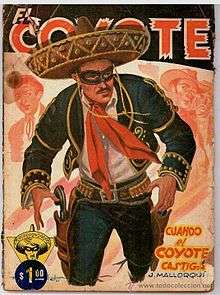
Queromon Editores, Argentina
El Coyote pulp novel #28, 1949
César was born in Los Angeles (originally called "el Pueblo de Nuestra Señora la Reina de los Ángeles"), which he left around late 1843 for Mexico and later Havana (Cuba) to study and "become a man". He "officially" returned in December 1851, described in the very first novel, El Coyote, although operating as El Coyote in California several times before that, secretly leaving Mexico during his years abroad.
César de Echagüe alias "El Coyote"
In Mallorquí's first novel, El Coyote,[49] one can trace that César must have been born around 1827 (the novel says he was 25 by his arrival in Los Angeles in late 1851).[50] One can read about Coyote's debut in La primera aventura del Coyote.[51] an early Extra novel,[52] where César was inspired by a masked female actress and by the Zorro legend when he started operating as El Coyote.[53] Coyote later told his son, "El Cuervo", in the stories on César Jr's adventures of late 1972 (when Jr was around 17 years old), that "El Coyote" debuted even younger than his son, long before aged 20.[54]
Coyote's original family
Coyote's father, who had experienced the turbulent years of Spanish and Mexican California, was Don César de Echagüe (II), who found out Coyote's true identity just prior to his death soon after César's first marriage.[55] César's sister Beatriz (aka Beatrice) was born in 1833 - she married Washington resident, political employee and member of the U.S. government, Edmond Greene (aka Edmonds or Edmons, nicknamed Edmondo), who spoke fluent Spanish. Both knew of Césars double identities (Edmond from late 1851 - Beatriz soon after) and settled in Washington in 1853 (although later often visiting California).[56] César's first wife Leonor de Acevedo (aka Leonora/Leonore) was born around 1830 (on yet another big ranch nearby San Antonio - and was betrothed to César already as a child). She became aware of Coyote's double identity by the end of the very first written novel. They married in 1852 during a two years period of Coyote retirement. She died around late 1856, when César Jr was born.[57] Jr called himself El Cuervo (no mask), the Raven, from around late 1872 - although he later abandoned it. César (Coyote) left Los Angeles again directly after his wife's death (even travelling to Europe and Spain) for several years (handing over the child-care to maiden Guadalupe Martinez).
Coyote's second wife
César was abroad again (Europe this time) during 1857-early 1965. Long before his official return in the spring of 1865 César secretly worked as Coyote, and outside California as unmasked José Martinez, after only a few years abroad - one adventure was specifically dated 1859, La sombra del Coyote (with a preface of 1849). At least for a while during the civil war (1861–65) César secretly worked as a neutral Union (northern) Commander at a San Carlos, San Diego fortress under the alias of "Delharty" (shortly before his second return to L.A. in early 1865 - encouraged by Edmond Greene), working to keep California out of the war, helping both northernness and southernness in El Capataz del Ocaso and its sequels (where César looks back from the mid 1870s to the last year of the war). Guadalupe was nicknamed Lupe/Lupita (aka Guadelupe).[58] She was the daughter of Julian Martinez, Coyote's very first close allied (from 1851) and chief servant (and foreman at César's father Don César's ranch). Julian died just prior to Guadalupe's marriage. Lupe was born in 1835 and married César around late 1870 - in El Diablo en Los Angeles. She and Julian had known of César's double identity from very early on - Julian was told by Coyote (probably even before 1851 - and Lupe found out by "accidental coincidence" in 1853 - La vuelta del "Coyote"). César's and Lupe's child Leonorin was born in 1871 - and fosterchild Eduardito (Gomez de la Mata) that same year (in Rapto). Guadalupe later became de Torres (Julian's real name) and suddenly - in 1872 (El código del Coyote and its sequels) - was even much richer than César, inheriting a huge farm (Rancho del Todo) in Coahuila in north Mexico, where she had to spend several months each year with her daughter (the formal heiress) to claim her rights.[59] In around 1875/76 she gave birth to a son (Nuevo Coyote Apostando su vida).
Coyote's allies
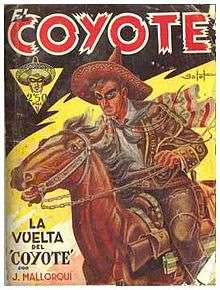
Spanish Ediciones Cliper El Coyote
pulp novel #1, September 1944
Coyote had some interesting early allies (friends). Among the first (besides Julian) were the Lugones brothers - Los Lugones - Juan, Timoteo, Evilio, and Leocadio (originally four, but Leo died early) and the old Indian woman Adelia. They helped Coyote from the very first beginning through all the years, and did not know about Coyote's real identity. Two other characters, though, knew - Ricardo Yesares and Matias Alberes. Yesares (from Paso Robles in San Luis Obispo), Coyote's sub/double throughout the years from 1865 (who Coyote had saved from "unfair" hanging that year) debuted in El otro "Coyote",[60] ediciones Cliper number 6 - the first adventure in Coyote's "second arrival". Ricardo was born around 1839/40, and married Serena Morales in Los Angeles in 1866, where he had become the owner of Hotel del Rey Don Carlos III (Coyote's new and "secret headquarters").[61] Coyote's closest allied from 1865 was César's servant (and "bodyguard"), the deaf Indian Matias Alberes (who even sometimes acted as a third Coyote, and was a Coyote allied at least up to around 1874 - he even was featured with Pedro Bienvenido in Los apuros de don César and later novels).[62] Gunman Mario Lujan (who initially was an enemy of Coyote in Al servicio del Coyote) helped him several times in later novels (and ended up as foreman at the San Antonio ranch). César Jr (the heir of the Acevedo farm) had two good friends in Joao da Silveira and César de Guzmán.[63] He met them in around late 1872 (El Cuervo en la pradera). The skilled Indian Pedro Bienvenido (who was some kind of mind-reader) became an important allied of Coyote and his son César de Echagüe y Acevedo soon after (he debuted in La reina del valle, also featuring Analupe de Monreal).[64]
Other early Coyote characters

The Coyote novels'
issue #2, 96 pages
Lindqvists Förlag,
Stockholm 1954
Swedish version of
La Vuelta del Coyote
Several of the novels' characters appeared throughout the series. Among them, Fray Jacinto at the mission station San Juan de Capistrano, who knew of Coyote's identity (and tried to get César to marry Lupe - he was the only one knowing Julian's true background). He was murdered in late 1872. Later there was Fray Anselmo at San Benito de Palermo. Don Goyo Paz fought in the Mexican-USA war and was a ranchowner not too far from San Antonio - Los Lugones were hired bodyguards at Don Goyo's. His son Gregorio Paz was to marry Guadalupe, but "El Diablo" forced César to marry her instead. There were solisitor José Covarrubias, doctor Garcia Oviedo, and Los Angeles sheriff Teodomiro Mateos - sheriff twice (1860s and 1870s), and in later years one of César's best friends. Former civil war spy Ginevra St. Clair appeared in 1869 (El exterminio de la Calavera, where César fell in love with her, but she died). There also were three more adventurers who appeared in several novels - Chris Wardell, "El Diablo", and "Princess Irina" (she debuted in Otra lucha in early 1870, and soon tried to charm César, but ended up as the partner of "El Diablo" after César's marriage). All three started out as some kind of enemies of Coyote. Anita was Guadalupe's maiden, and San Francisco chief vigilante Captain Farrell became a good friend of Coyote.[65] Another noble ranchowner was Don Rómulo Hidalgo (with his son Justo). In the novels there were of course also a lot of villains - Coyote's worst and toughest enemy probably was Robert Toombs (featured in Guadalupe and its sequels around 1872).[66] Several novels were adventures in sequels (one special long one was Coyote´s adventures with Analupe De Monreal around 1873).[67]
Films
- El Coyote, 1955 Spain & Mexico starring Mexican Abel Salazar (shot 1954)
- La justicia del Coyote (The Coyote's justice), 1956 Spain & Mexico with Abel Salazar (also shot 1954)
- El vengador de California - in Italy aka Il segno del Coyote,[68] in Brazil and Portugal as A Marca do Coyote,[69] (also on DVD), 1963 Italy & Spain starring Mexican actor Fernando Casanova
- La vuelta del Coyote (The return of El Coyote),[70] 1998 Spain starring José Coronado,[71] (shot in 1997).[72] Film aka La vuelta de El Coyote (often listed as a Portugal film),[73] and aka El Coyote - La Pelicula (the movie)[74]
Comics and Radio
El Coyote had a comic series adaptation in Spain, Cliper comics - 113 in the first series by Jose Mallorquí and Francisco Batet (from 1947 up into 1953)[75] with a total of 189 adventures up to 1955,[76] plus 14 more (2a Epoca) later on - with a late revival 1983 on Comics Forum,[77] and even later Batet's originals on Agualarga hard-bound.[78] There was also a long-running Spanish radio series on SER with many episodes,[79] featuring Vicente Mullor.[80]
References and Notes
- ↑ El Coyote, the first novel was published by Editorial Molino, but all the novels in the "El Coyote" series (starting a year later - including a reissue of the "debut novel") were published by Ediciones Cliper (Germán Plaza, editor)
- ↑ Josë Mallorquí Biografía with short presentation and rare images at El Bibliófilo Enmascarado
- ↑ "el" is Spanish for "the" (in Italy and Brazil "o"), the German and Scandinavian novels mostly were published without prefix
- ↑ El Coyote in Novelas del Oeste at pinterest.se, with images of lots of Mallorquĭ novels (including his pseudonyms) by different publishers (note the "Batlle" signature for Batet)
- ↑ from p.239, López, Enrique Ávila MODERN SPAIN - Understanding modern nations, ABC-CLIO, USA Dec 2015, 978-1-61069-600-5:
"José Mallorquí Figuerola (1913-1972) was the best selling writer of Spain's 20th century. Although relatively unknown among Spanish academia, Mallorquí was the pioneer of Spanish pulp fiction. He started as a translator of Agatha Christie and Earl Derr Bigger's works for Molino Publisher. Mallorquí also created a series of novels inspired by the Wild West, including Tres Hombres Buenos, Jibaro, and Miss Moniker. He brought to Spain the American pulp magazine "Weird Tales" and was a pioneer on radio shows with series such as Los Bustamante, Dos Hombres Buenos, and El Coyote. The latter derived from his short novel El Coyote (1943) written under the pseudonym Carter Mulford. The figure of El Coyote would become the main character of more than 190 novels and (ed: as much) comics, and several movie adaptions. Mallorquí was a great aficionado of North American history as well as the role of Spain in the conquest of America. Like many great storytellers of his caliber, Mallorquí put emphasis on the adventure, making his writing educational while also entertaining." - ↑ Coyote Bibliography reviewed at web.archive
- ↑ p.314 Stephan, Alexander The Americanization of Europe: Culture, Diplomacy, and Anti-Americanism after 1945 Berghahn Books, 2006
- ↑ Cliper hardbound early novels
- ↑ Forum hardbound
- ↑ the Ediciones Cliper novels the original pulps presented by Miguel Angel Muñoz Rodriguez on the Novelas Coyote web site
- ↑ the very first written novel, El Coyote full novel on an "easy-read" pdf-file (Forum version - and the Cid novels pictured)
- ↑ Comiclopedia index of illustrators
- ↑ which tells a story of Anglo-American tries of cheating a small farm out of an innocent native Californian (in 1853 after César's marriage to Leonor), featuring Leonor, Julian Martinez, the young Guadalupe (Julian's daughter, who plays a key role in the novel) and at this time unexperienced solisitor Josė Covarrubias, plus Adelia and Los Lugones
- ↑ La vuelta del Coyote - full excerpt
- ↑ Ediciones Cátedra In September 2013 Cátedra published a 432 page (with six inside images) 20x13 cm pocket book, El Coyote, which featured El Diablo en Los Ángeles and Don César de Echagüe (both from the original Cliper novels). It was edited by expert Ramón Charlo (with introduction and special notes) plus prologues by César Mallorquí and Louis Alberto de Cuenca.
- ↑ Ediciones Cid a complete collection imaged in one photo with a link to Coyote pulps and comics for sale
- ↑ Editions and illustrators at La Nueva Web El Coyote
- ↑ Editorial Bruguera complete collection
- ↑ Favencia complete collection
- ↑ Ediciones Forum complete collection
- ↑ First novel El Coyote replica preview
- ↑ For collectors: Forum and Planeta DeAgostini each had their "El Coyote: Numero 0" with differing short articles on the novels (some by Mallorquí himself) and complete listings of their novel series
- ↑ Planeta DeAgostini complete collection
- ↑ Coyote exhibition in Madrid in 2016
- ↑ The very first capital of California was Monterey, in the old Alta California under Spain and Mexico. Soon after the U.S. take-over, San Jose was chosen - and in 1854 Sacramento became the capital. Mallorquí spelt it Monterrey (as the city in Mexico). Baja California is the northern part of Mexico's Baja California Peninsula.
- ↑ Fictive - not the San Antonio Valley outside San Francisco, but inspired from the Mount San Antonio in the Los Angeles and San Bernardino two counties
- ↑ Los Angeles population and synopsis of the original "El Coyote" novel; L.A. population 1830: 770, 1850: 1.610, 1870: 5.730
- ↑ "El Coyote" Personajes J. Mallorquí cited in Novelas Coyote Characters
- ↑ "El Coyote" Ediciones Cliper Extra #0 (the chronical-first Coyote-novel of 1945 - originally published in "Novelas Del Oeste" in 1943)
- ↑ Novelas Coyote web site at La Nueva Web El Coyote
- ↑ Louis Alberto on Coyote with several clips of the 1998 Mario Camus and César Mallorquí (son of José) movie "La vuelta del Coyote" and links to two earlier films, "El Coyote" and "El vengador de California"
- ↑ Some of the very early novels (and the first drawings by Batet)
- ↑ Novelas Coyote - Ed. Cliper (1944-1953) The 192 Spanish pulps on different editions at La Nueva Web El Coyote by Miguel Muñoz
- ↑ Coyote expert Ramón Charlo tried to sort the novels chronological in one of his books on Mallorquí (on Planeta deAgostini) and Coyote (three on Padilla - characters, places, and facts) - reference books of 2000-2005
- ↑ "Centenario Numero Extraordinario" Full excerpt from Cliper number 100 El diablo, Murrieta y el Coyote (diablo is not the later "El Diablo" - diablo here is Murrieta)
- ↑ Nuevo Coyote #35 El Hombre Tras La Máscara, a late novel featuring César, Guadalupe, Bienvenido (who had taken over Alberes' role at the San Antonio ranch, where the hosts held weekly poker playing events), César Jr, Leonorin, Anita, Yesares, Mateos, Los Lugones and Adelia (mid 1870s), where César is accused having had love affairs, not only with Ginevra St. Clair, but also with Princess Irina, Analupe de Monreal, and Thalia Coppard (from an earlier Nuevo Coyote, El hijo de Thalia Coppard), and finds César Jr getting very upset about it
- ↑ The first 130 novels had the text in two columns - the Nuevo Coyotes in one (with issue numbers 51 and 52 lacking the "Nuevo stamp")
- ↑ Los asesinos llegan a Monterrey text
- ↑ Los asesinos van a Monterrey cover and inside
- ↑ After the first issues in Spain from 1944 followed Italy (1947), Argentina (1948), Austria and Germany (1949), England (1951, only o total of 11 novels were published), France (14 issues on Librairie Moderne) and Norway (1952), Denmark (probably around 1953), Finland (1953), Sweden (1954), Brazil (1956), and Portugal (1968, ten issues) - plus Mexico (Ediciones Cliper), Belgium (Librairie Moderne) and Switzerland (German publisher). Coyote international publishers
- ↑ "Catalogo El Coyote" by Ernesto Vegetti at fantascienza.net with 13 different countries' editions presented and the international publications. Actually only 47 of the 51 Swedish flagged novels were issued (so the flags at La hacienda tragica, La ley de los Vigilantes, Al servicio del Coyote, and De tal palo... should not be there)
- ↑ The original first 74 German Coyote pulps (out of 84) at "Good Old West"
- ↑ The novels of Finland at perubanaa.net
- ↑ Harald Damsleth at www.dast.nu
- ↑ Novels of Brazil at Gibi Raro
- ↑ Italy, Austria, Finland (and possibly Mexico) were the only countries outside Spain, who published this unique extra novel (fantascienza.net)
- ↑ Leocadio Lugones was featured frequently in the novel. This "Extra Especial" also had Mallorquí presenting the main characters of the early novels in a suppplement, not featured in all of the later Spanish editions
- ↑ The order of the Extras' original publishings (in comparison to the regular issues) are approximative (with differing information given in later presentations).
- ↑ Ediciones Cliper Extra #0 - the full excerpt (with annotation) from Josė Mallorquí's very first Coyote novel (at Cuentos Historias del Mundo). At the end of the story you will find a 48-page pdf-file (via Print Friendly click), but here you will find the pdf-file direct.
- ↑ No absolute year of birth is given in the novels, although different, conflicting, ages are mentioned several times throughout the stories (in El otro "Coyote", an around 30 year old César is mentioned, and that story takes place in early 1865). Mallorquǐ deliberately may have made Coyote a bit younger after 1865
- ↑ La primera aventura del Coyote - full excerpt. In the novel César looks back 23 years from around 1869/1870. The date of the early happenings in the story is somewhat conflicting - it tells a story of 1846 and January 1847 (when California/Mexico was at war with the U.S.A.). Other novels tells us César was in Mexico or Cuba in 1846, leaving the San Antonio ranch in around 1843 (so it looks like one of César’s secret visits to California, even though the novel says he was at home here)
- ↑ The ten Extras of the Novelas Coyote - Edition Cliper (1945-1946)
- ↑ In the very early novel Huracán sobre Monterrey (a story of around 1855 - and in the first El Coyote) Mallorquí writes César "officially" was abroad for eight years up to December 1851, meaning he left his family around 1843 (maybe yet another try by Mallorquí to make Coyote a bit younger after the first novels)
- ↑ Mathematics: 1827 plus 16 equals 1843 (and 1831 plus 16 equals 1847). His second absence, from 1857, also lasted for almost exactly eight years
- ↑ in the Extra Especial Cliper novel
- ↑ Several novels in the series feature César, and later also Guadalupe, visiting Washington, and meeting President Grant (1869-77) - the first time already in 1869
- ↑ Roberto Barreiro on César Jr in later years, and his connections to Nick Carter, where Barreiro states the birth of César Jr to 1855 - and refers to a story of César Jr after 1887. Jr marries Wallace (unknown first name) and they go to Spain for a honeymoon, where a son James is born, who becomes Jim Wallace ("subbing" for Nick Carter in Spanish Molino pulps). He also states that El Coyote more or less retired for good in around 1875 to concentrate on his ranch together with Jr
- ↑ The Swedish Coyote novels and its original Spanish editions
- ↑ Ramón Charlo El Coyote - Los Personajes, Padilla Libros, 2000
- ↑ El otro Coyote E-book replica preview at de.scribd.com - the novel of César's return to L.A. in 1865 (with several more preview replicas to find)
- ↑ with secret passage from Yesares' office to at least one of the guest rooms (to which Yesares directed the villains staying in the hotel)
- ↑ Characters in early Coyote pulps with illustrations of several characters (as presented in different editions of the novels)
- ↑ A Portuguese and a Spaniard, who had "ridden" with young Mexican Diego de Abriles in several early pulps, written by Mallorquí under the pseudonym of Amadeo Conde on Molino 1942-1947, 3 hombres buenos, and a movie in 1963. The two adventurers later "rode again" in further pulps in the long-running Dos hombres buenos Cid novel series (around 100 volumes) from 1955 for sveral years (also in a radio show).
- ↑ Swedish Coyote novels, Lindqvists Förlag, Stockholm-Sweden, 46 volumes published 1954-1960
- ↑ "Frisco" was much larger than L.A. in those days and had almost 25 times the population in 1870, with 30.000 in 1850
- ↑ All the characters are picked from the original 130 pulps. The datings are either picked directly from the novels or approximately interpreted through the stories' chronology (dates are sometimes slightly conflicting in the various novels)
- ↑ Analupe De Monreal Clipel novel #61 full text
- ↑ Il segno del Coyote film poster
- ↑ A Marca do Coyote (The sign of Coyote) film on dvd
- ↑ La vuelta del Coyote (La vuelta de El Coyote) film poster
- ↑ 1998 film trailer
- ↑ La Vuelte del Coyote clips at Filmotech
- ↑ La vuelta de El Coyote the full film on fulltv.com
- ↑ Release Guide at todocollection.net with José Coronado images
- ↑ Studio Comics
- ↑ The original Cliper comics with lots of cover images
- ↑ Comic Vine 1983
- ↑ Batet comics hardbound
- ↑ Coyote Review by Armando Boix
- ↑ Vicente Mullor
External links

The first Swedish Coyote novel,
"The masked rider"
Lindqvists Förlag,
Stockholm 1954
("El Coyote" 1943)
Complete Audio Files
- Las Aventuras del Coyote - Full Audio files of all 192 novels at ivoox.com channels by kitsume (with short text intro for each novel and the audio files divided in short episodes - the first novel starting with a short annotation by Antonio Martin (Forum editions) - click on Descargar (choose channel ... and learn some Spanish - and possibly some Catalan)
El Coyote fan sites
- "La Nueva Web El Coyote" www.novelascoyote.com (Spanish Coyote Site, created by Miguel Muñoz) - with the first 130 novels in chrono order - not with their original issue numbers (107 with synopsis, and the total 192 listed) plus lots of information, including images of Spanish covers of all editions from 1944 to 2004 (a total of 686 novel covers), except for Cid
- El Coyote Catalog www.fantascienza.net (Italian Coyote Site) - including Ediciones Cid - and the novels from the whole world, imaged in order of the Italian pulp series
- Coyote Bibliography dreamers.com - with Cliper in publ. order
- Swedish Coyote Site serielagret.se - with images of all Swedish Coyote novels and the complete Cliper catalog (in order of original publishing)
- Swedish Coyote Blog coyote-bloggen.se - with synopsis of the first 124 pulps in Swedish (same chronological numbering as the Spanish Coyote Site)
- Archive Novels List of Finland's 78 novels at Makedonia & Moog (with covers of them all, but also some other countries' equivalents)
Other sites
- Full text excerpts from Coyote novels at Cuentos Historias del Mundo (sometimes hard to find all the texts - one has to try different searching "methods")
- Short presentation and El Coyote portrayed (in 1998 by José Coronado) very close to how Mallorquí originally "pictured" him (although he operated in California - not Baja, Mexico as the site says)
- Coyote Collection shown live Collection of El Coyote novels shown at biblioteca del Museo Etnográfico in Madrid
- El Coyote Cabalga de Nuevo "Coyote Rides Again" at elcoyotecabalga.blogspot (with images of back covers of the Favencia novels - and more)
- Manuel Collado Luque reflects on El Coyote
- Mallorquí presented chronological at sugarhoover (treasures)
- Coyote on Facebook: El Coyote, de José Mallorquí and EL COYOTE
- Forum and DeAgostini Coyote pulps to buy
- Lots of Coyote novels for sale with covers and inside illustrations imaged and one more list